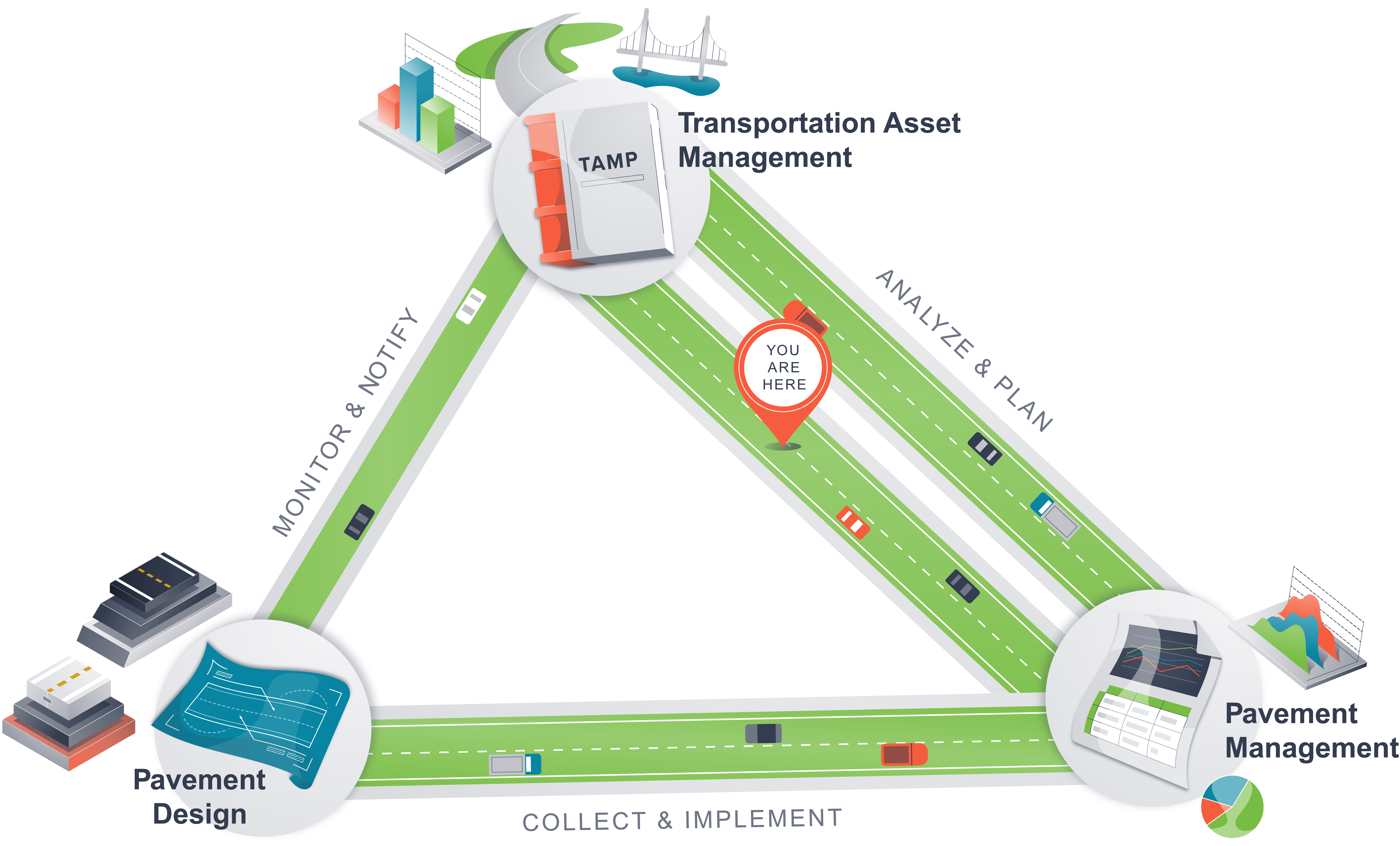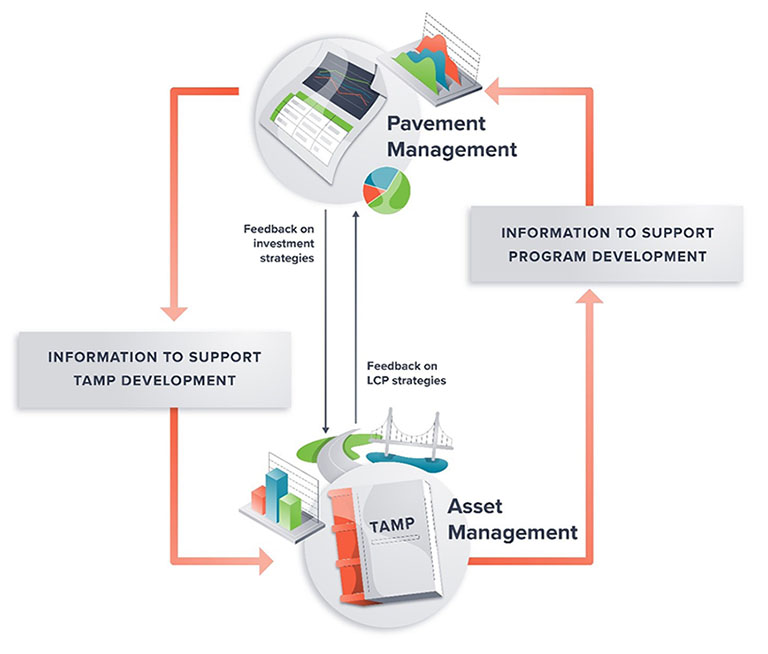Linking Pavement Management to Transportation Asset Management (TAM)

Pavement design, pavement management, and transportation asset management (TAM) are linked because each function relies on information provided by the other two. This webpage provides information on the links between asset management and pavement management, including their importance; what data, systems, and organizational units support them; and how links between the two can be strengthened. TAM is "a strategic and systematic process of operating, maintaining, and improving physical assets, with a focus on both engineering and economic analysis based upon quality information, to identify a structured sequence of maintenance, preservation, repair, rehabilitation, and replacement actions to achieve and sustain a desired state of good repair over the life cycle of assets at minimum practicable cost” (23 CFR 515.5). Pavement management refers to "a set of tools or methods that assist decision-makers in finding optimum strategies for providing, evaluating, and maintaining pavements in a serviceable condition over a period of time" (AASHTO 2012). Estabilishing a link between pavement management and TAM can support the development and implementation of long-term asset management strategies to achieve the desired state of good repair (DSOGR) at minimum practicable cost. Two primary examples of the connection between pavement management and TAM include:
- Pavement management analysis results are used to develop life cycle plans in a Transportation Asset Management Plan (TAMP).
- TAMP investment strategies are used as budget inputs for pavement program development.
Additional examples of information passed between these two functional areas, as well as critical feedback loops, are discussed in the sections below. The discussions are broken into topics focused on policy and procedural links, organizational links, and systems and data links.
 Policy and Procedural Links Between Pavement Management and TAM
Policy and Procedural Links Between Pavement Management and TAM
Life Cycle Planning
LCP for pavements involves the use of pavement management systems (PMS) to evaluate different strategies for applying maintenance, preservation, rehabilitation, and eventual reconstruction throughout the life of a pavement to minimize life-cycle costs and maximize service life. State Departments of Transportation (DOTs) are required to develop a process for conducting LCP for an asset class or asset sub-group in developing risk-based TAMPs (23 CFR 515.7(b)). This process results in analysis that leads to the identification of preferred LCP strategies that are then used to develop TAMP investment strategies. Life cycle planning is distinct from life cycle cost analysis (LCCA) and is critical in linking pavement management and asset management.
Life Cycle Planning versus Life-Cycle Cost Analysis
"LCP is a network-level analysis. This means it considers numerous assets within the same asset class. It may be performed for an entire inventory, or any set of assets within the agency's inventory. LCP is separate and distinct from a LCCA, which is generally performed at the project or asset level. Project-level LCCA is typically performed to select the preferred design alternative, as part of preliminary project engineering."
Source: FHWA. 2019. Using an LCP (Life Cycle Planning) Process to Support Transportation Asset Management: A Handbook on Putting the Federal Guidance into Practice.
Investment Strategy Development
TAMP investment strategies describe a set of strategies aimed at achieving State DOT targets for asset condition and system performance effectiveness at a minimum practicable cost while also managing risks (23 CFR 515.5). The investment strategies are informed by evaluating various levels of funding and the expected approach to investment across the five work types (maintenance, preservation, rehabilitation, reconstruction, and new construction) as provided in the financial plan component of the TAMP. Pavement management can support the development of investment strategies by analyzing different funding scenarios in combination with the preferred life cycle strategy. Investment strategies are typically described in the TAMP in both narrative form and in the form of a table showing the expected level of annual investment in each of the five work types.
Investment strategies are network level and do not identify specific projects. However, some major projects that are already under development may need to be considered when developing the broader investment strategy. PMS can support the network- and project-level aspects of investment strategy development.
Program Development
Once the pavement investment strategies are established, the PMS is again used to identify and prioritize candidate projects that fulfill the investment strategy and align with the pavement life cycle strategy. This initial set of recommended projects represents a cost-effective way to achieve pavement condition objectives; however, it is often not feasible to implement the full set of recommendations from the PMS. This is due to many factors, such as agency priorities, not considered in the PMS or unexpected demands for funding. Some degree of project-level pavement evaluation is commonly used to vet the PMS recommendations before identifying the final list of proposed projects. To strengthen the link between pavement design and TAM, it is important that the pavement condition inputs to these PMS scenarios include treatment trigger values and other treatment warrants that are aligned with similar inputs to pavement design standards, such as design life and failure criteria.
In addition to developing the TAMP, an asset management office is typically very connected to the agency’s capital or maintenance program development efforts. For example, the California DOT’s (Caltrans) asset management office supports the development of the agency’s State Highway System Management Plan (SHSMP). This plan provides a comprehensive overview of investments related to the maintenance, rehabilitation, and operation of the California’s state highway system (Caltrans 2021).
Target Setting
Since asset management offices have a significant role related to investment strategy and programming, the asset management unit will also typically lead or contribute to the target setting activities for the assets under their purview. The connections among targets, strategies, and project selection can greatly increase the agency’s ability to set reasonable targets and to then achieve those targets. However, achieving targets can still be a challenge, particularly for agencies with decentralized program delivery processes. Indiana DOT has worked to overcome this challenge by having area engineers that work closely with District planners and designers to scope pavement projects.
 Organizational Links Between Transportation Asset Management and Pavement Management
Organizational Links Between Transportation Asset Management and Pavement Management
In recent years, agencies have begun to establish internal units that oversee asset management across a range of assets within a single organizational unit. These units can go by many names, but herein will be referred to as asset management offices. An asset management office will typically oversee the development of the TAMP, performance modeling, and scenario analysis of pavements, bridges, or other assets such as, but not limited to, culverts, ancillary structures, or Intelligent Transportation Systems.
The office is typically led by an asset manager who is a senior manager within the agency. Asset managers serve as the primary point of contact regarding the TAMP, asset management investment strategies, and the use of scenario analysis results. They work closely with executive leadership, other State DOT managers, and external stakeholders to coordinate TAMP development and investment programming. The asset manager will typically represent the agency in meetings with stakeholders, such as Metropolitan Planning Organizations (MPOs), or when collaborating on asset management targets, strategies, or investment priorities.
The asset manager is typically supported by asset-specific units that oversee functions such as data collection and management, modeling, analysis, and reporting. The asset management office may oversee data collection for the assets within its purview or it may work closely with other units to collect needed data.
As an example, the Indiana DOT has established an asset management group (AMG), as described further in the case example below. The Indiana AMG supports the development of the TAMP investment strategies, assists in the development of programs such as the Statewide Transportation Improvement Program (STIP), and works closely with district offices to ensure that the project scopes align with those strategies and programs.
Indiana DOT Asset Management Group
In 2017, following passage of a new funding bill, the Next Level Road Program, which increased funding for highway and bridge preservation and construction, Indiana DOT established the AMG. The AMG brought together both pavement and bridge management units under the Program Management Group.
The role of the Indiana DOT’s Pavement Management Unit (PMU) is to set policy, establish goals, and develop project needs using analysis results from the PMS. Within the PMU, the three area engineers are responsible for developing the statewide paving program and supporting their assigned districts in executing the plan. Using PMS recommendations, the area engineers work with district pavement engineers, geotechnical engineers, and pavement design teams to develop project scopes that fit within the strategies developed through the PMS and meet the needs of each specific project location. This collaborative approach has allowed Indiana DOT to improve the performance of its pavements as well as the on-time and on-budget performance of paving projects.
 Systems and Data Links Between Pavement Management and TAM
Systems and Data Links Between Pavement Management and TAM
As described above, pavement management and TAM are linked through numerous processes, each sharing information and data. For each process, information flows from one unit to another in support of achieving a business need of the agency, such as developing the TAMP or identifying pavement projects. Typically, documented procedures for these processes describe the information that is passed from the unit which creates the information and the unit which receives it. Information to support TAMP develop flows from Pavement Management to Transportation Asset Management, and information to support program development flows from TAM to Pavement Management. Ideally these procedures provide regular feedback from the recipient to the provider to strengthen the link between pavement management and TAM. The following graphic shows examples of information that is passed between these two units in support of processes described above. The thick lines in the graphic show the primary flow of information in support of each process, while the thin lines show the flow of feedback.
Typical Transmittals from Pavement Management to Asset Management
- Current pavement inventory and conditions
- Federal HPMS reporting
- State reporting
- Network-level work types, treatment categories, and costs
- Life cycle strategies
- Treatment definitions and costs
- Treatment warrants
- Prioritization rules
- Scenario analysis results for forecasted conditions for current, anticipated, and alternative funding scenarios
- Funding needs to achieve targets or desired state of good repair (DSOGR)
- Recommended expenditures for maintenance, preservation, rehabilitation, and reconstruction of pavements
- System wide highway safety projects and initiatives (pavement)
Potential Feedback from Asset Management
- TAMP consistency review findings
- Feasibility of recommended expenditures
- Inputs / adjustments to inputs for scenario analyses to support TAMP development
- Alignment between State treatments and Federal work types
- Completeness of information, e.g., do strategies and needs consider work performed by field maintenance crews?

Typical Transmittals from Asset Management to Pavement Management
- National performance measure criteria
- National condition measures and targets
- 10-year TAMP investment strategies
- State condition measures and criteria
- State condition targets
- DSOGR
- Performance gap analysis components
- Recommended funding allocations, by asset class (pavements), highway system, district/region, and project category (reconstruction, rehabilitation, preservation)
Potential Feedback from Pavement Management
- Feasibility of targets and desired SOGR based on available funding and treatment constraints
- Feasibility of investment strategies and allocations
- Correlations between state and federal measures
- Reasonableness of data requests given the capabilities of the pavement management system
REFERENCES
American Association of State Highway and Transportation Officials (AASHTO). 2012. Pavement Management Guide, Second Edition 2012. AASHTO, Washington, DC.
California Department of Transportation (Caltrans). 2021. State Highway System Management Plan – Draft. California Department of Transportation. Sacramento, CA. https://dot.ca.gov/-/media/dot-media/programs/asset-management/documents/2021_shsmp_draft_04-27-21.pdf

